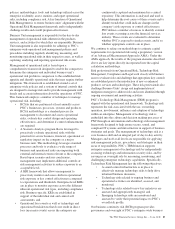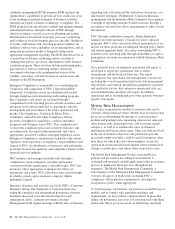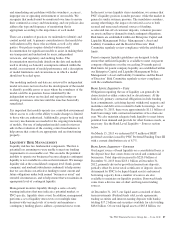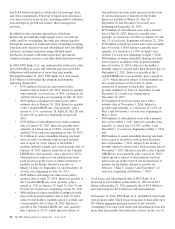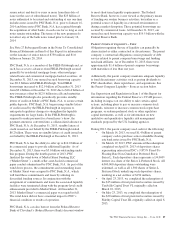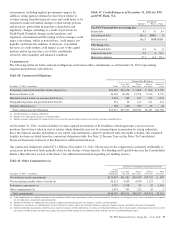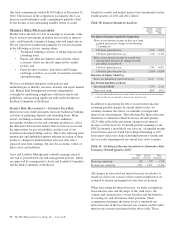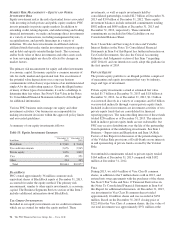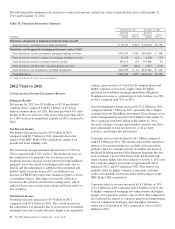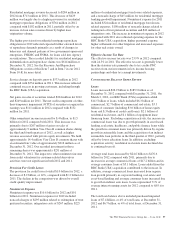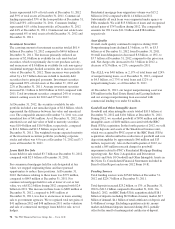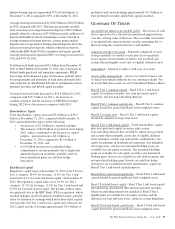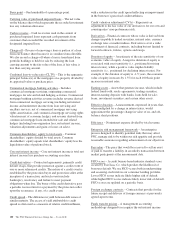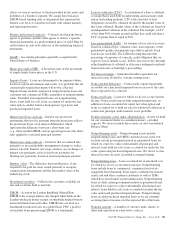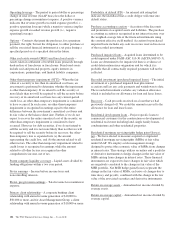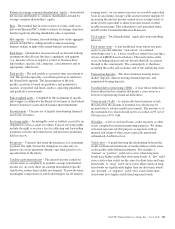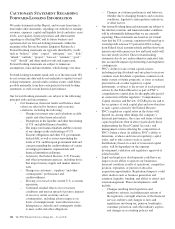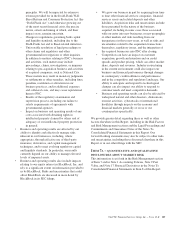PNC Bank 2013 Annual Report Download - page 113
Download and view the complete annual report
Please find page 113 of the 2013 PNC Bank annual report below. You can navigate through the pages in the report by either clicking on the pages listed below, or by using the keyword search tool below to find specific information within the annual report.current conversion rate, which reflects adjustments in respect
of all litigation funding by Visa to date. The Visa Class B
common shares that we own are transferable only under
limited circumstances (including those applicable to the sales
in 2013 and 2012) until they can be converted into shares of
the publicly traded class of stock, which cannot happen until
the settlement of certain specified litigation. It is expected that
Visa will continue to adjust the conversion rate of Visa Class
B common shares to Class A common shares in connection
with any settlements of the specified litigation in excess of
any amounts then in escrow for that purpose and will also
reduce the conversion rate to the extent that it adds any funds
to the escrow in the future.
Note 24 Commitments and Guarantees in the Notes To
Consolidated Financial Statements in Item 8 of this Report has
additional information regarding the October 2007 Visa
restructuring, our involvement with judgment and loss sharing
agreements with Visa and certain other banks, and the status
of pending interchange litigation. See also Note 27
Subsequent Events in the Notes To Consolidated Financial
Statements in Item 8 of this Report for detail on our sale of
1 million Visa Class B common shares in January 2014.
O
THER
I
NVESTMENTS
We also make investments in affiliated and non-affiliated
funds with both traditional and alternative investment
strategies. The economic values could be driven by either the
fixed-income market or the equity markets, or both. At
December 31, 2013, other investments totaled $234 million
compared with $245 million at December 31, 2012. We
recognized net gains related to these investments of $39
million during 2013, compared with $55 million during 2012.
Given the nature of these investments, if market conditions
affecting their valuation were to worsen, we could incur future
losses.
Our unfunded commitments related to other investments were
immaterial at both December 31, 2013 and December 31, 2012.
See the Supervision and Regulation section of Item 1 Business
and Item 1A Risk Factors for additional information on the
potential impact of the Volcker Rule on PNC’s investments in
and relationships with private funds that are covered by that
rule, as well as PNC’s ability to maximize the value of its
investments in such funds.
I
MPACT OF
I
NFLATION
Our assets and liabilities are primarily financial in nature and
typically have varying maturity dates. Accordingly, future
changes in prices do not affect the obligations to pay or
receive fixed and determinable amounts of money. However,
during periods of inflation, there may be a subsequent impact
affecting certain fixed costs or expenses, an erosion of
consumer and customer purchasing power, and fluctuations in
the need or demand for our products and services. Should
significant levels of inflation occur, our business could
potentially be impacted by, among other things, reducing our
tolerance for extending credit or causing us to incur additional
credit losses resulting from possible increased default rates.
F
INANCIAL
D
ERIVATIVES
We use a variety of financial derivatives as part of the overall
asset and liability risk management process to help manage
exposure to interest rate, market and credit risk inherent in our
business activities. Substantially all such instruments are used
to manage risk related to changes in interest rates. Interest rate
and total return swaps, interest rate caps and floors, swaptions,
options, forwards and futures contracts are the primary
instruments we use for interest rate risk management. We also
enter into derivatives with customers to facilitate their risk
management activities.
Financial derivatives involve, to varying degrees, interest rate,
market and credit risk. For interest rate swaps and total return
swaps, options and futures contracts, only periodic cash payments
and, with respect to options, premiums are exchanged. Therefore,
cash requirements and exposure to credit risk are significantly
less than the notional amount on these instruments.
Further information on our financial derivatives is presented
in Note 1 Accounting Policies, Note 9 Fair Value and Note 17
Financial Derivatives in the Notes To Consolidated Financial
Statements in Item 8 of this Report, which is incorporated here
by reference.
Not all elements of interest rate, market and credit risk are
addressed through the use of financial derivatives, and such
instruments may be ineffective for their intended purposes due
to unanticipated market changes, among other reasons.
The PNC Financial Services Group, Inc. – Form 10-K 95


